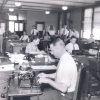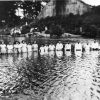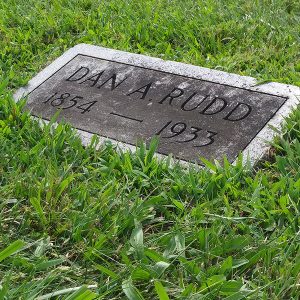calsfoundation@cals.org
Daniel Rudd (1854–1933)
Daniel A. Rudd was a lay leader within the Catholic Church during the late nineteenth and early twentieth centuries who used his own experience and influence to usher in a sense of black consciousness among Catholics in the United States and to advocate for the equality of all African Americans. He published the American Catholic Tribune, organized the first Negro Catholic Conferences, and developed relationships with some of the most influential black and Catholic leaders in Arkansas.
Daniel Arthur Rudd was born on August 7, 1854, in Bardstown, Kentucky. He was the eleventh of twelve children born to Robert Rudd and Elizabeth (Eliza) Rudd, who were enslaved to two different owners—Robert to Richard and Margaret Rudd and Eliza to Charles Haydon. Both of his parents worked as sextons at St. Joseph’s Proto-Cathedral, which was located near Haydon’s plantation. At this church, Rudd was baptized in 1854, learned the catechism, partook in his first communion in 1863, and likely shared church duties with his parents. In his book on Rudd, A Cry for Justice, Gary Agee noted that Rudd and his family experienced a high level of respect and equality within the Catholic faith during his early years in the Church, which possibly influenced Rudd to remain within the faith after the Civil War and to advocate for racial integration.
After Rudd’s father died in 1865, some of his siblings moved to Springfield, Ohio, to find work after the war. After remaining at St. Joseph’s for a few more years, he later followed them to Springfield, where he likely completed his education and training in the printing industry. During his time in Springfield, he shared a living space with a few of his brothers and began participating in demonstrations for African American rights, including integrated schools in Springfield. This activism continued into his career as a publisher and essentially became one of his primary purposes for publishing.
After a brief time in Columbus, Ohio, editing the Ohio State Review, Rudd eventually moved to Cincinnati, Ohio, in 1886 and began a partnership with James T. Whitson, a businessman from Pennsylvania. Together, they established a publication called the American Catholic Tribune, which became one of the most prolific black-owned weekly journals of the time. At its height in 1892, it boasted a subscription base of 10,000. The paper was produced in Cincinnati until 1893 and then in Detroit, Michigan, until 1897. It often identified contributions of black leaders and lambasted racist public policies. However, Rudd also took opportunities to promote Catholicism as an inherently welcoming institution for all people while also recognizing a need to combat racism within the Church itself. This led to his efforts to organize the first Colored Catholic Congress, which was held in Washington DC January 1–4, 1889. It brought together many prominent black Catholic leaders, who ultimately produced a call for further integration of African Americans into Catholicism and other social institutions. Rudd organized four more national Black Catholic Congresses through 1894, each of which intensified its demands.
In 1893, Rudd decided to move the publication base for his paper to Detroit as subscriptions began to decline. The American Catholic Tribune ultimately ceased publication in 1897, after which time Rudd briefly lived in Chicago, Illinois. Sometime before 1910, he had made his way south to Mississippi. There, he worked in the lumber industry until, in 1912, he came to Arkansas to help establish a sawmill for Scott Bond in Madison (St. Francis County).
During his years of employment with Bond, Rudd served as an accountant, an adviser, and a superintendent of Bond’s gravel and lumber businesses. He became very close to his employer’s family and even lived with Bond’s son, Theophilus. Rudd and Theophilus Bond together produced a biography of Scott Bond, though Rudd was likely the primary author. The book From Slavery to Wealth: The Life of Scott Bond: The Rewards of Honesty, Industry, Economy, and Perseverance (1917) highlighted the ability of African Americans to succeed if given the opportunity, which Rudd believed to be key in pursuing equality. By 1920, he had begun working as an accountant for the estate of John Gammon, a wealthy African-American farmer and businessman based in Marion (Crittenden County). During his time in Marion, Rudd likely taught black students, as his death certificate listed his occupation as a teacher.
In 1919, Rudd asked Bishop John Morris for permission to represent the Diocese of Little Rock in that year’s National Association for the Advancement of Colored People (NAACP) convention in Cleveland, Ohio. Although Morris denied the request to represent the diocese, Rudd did attend and present at the conference. He again asked the bishop to represent the diocese at a convention of black Catholic laymen in 1920, which was also denied due to there being so few black Catholics in Arkansas at the time. However, in 1926, Morris did call on Rudd to represent black Catholics in Arkansas at the Eucharistic Congress. Though he had lost a measure of notoriety since his time as a publisher and spent years in the South, Daniel Rudd remained committed to Catholicism. He continued advocating for equality and the ability of the Catholic Church to benefit African Americans in the United States.
While still living in eastern Arkansas in 1932, Rudd had a stroke. He moved back to his original home of Bardstown, Kentucky, and died there on December 3, 1933. He is buried at St. Joseph’s Cemetery. In Arkansas, Rudd’s legacy as a Catholic lay leader and civil rights advocate continues in the twenty-first century as the Diocesan Council for Black Catholics—an organization within the Diocese of Little Rock—presents the memorial Daniel Rudd Award to black Catholics in Arkansas whose work impacts the diocese. The first of these awards was given posthumously to Dr. Phyllis Greenhouse in 1985.
For additional information:
Agee, Gary B. A Cry for Justice: Daniel Rudd and His Life in Black Catholicism, Journalism, and Activism, 1854–1933. Fayetteville: University of Arkansas Press, 2011.
———. Daniel Rudd: Calling a Church to Justice. Collegeville, MN: Liturgical Press, 2017.
“The Bishop Speaks.” The Guardian, September 6, 1985, p. 3. Arkansas Catholic Newspaper Archive. http://arc.stparchive.com/index.php (accessed December 12, 2018).
Davis, Cyprian. “Black Catholics in Nineteenth Century America.” U.S. Catholic Historian 5, no. 1 (1986): 1–17.
Lackner, Joseph H. “The ‘American Catholic Tribune’: No Other Like It.” U.S. Catholic Historian 25, no. 3 (2007): 1–24.
———. “Dan A. Rudd, Editor of the ‘American Catholic Tribune,’ from Bardstown to Cincinnati.” Catholic Historical Review 80, no. 2 (1994): 258–281.
Mosely, LaReine-Marie. “[About the Cover]: Daniel A. Rudd: Civil Rights Leader and Black Catholic Lay Animator.” American Catholic Studies 122, no. 4 (2011): 105–112.
Raboteau, Albert J. “Black Catholics and Afro-American Religious History: Autobiographic Reflections.” U.S. Catholic Historian 5, no. 1 (1986): 119–127.
Spalding, David. “The Negro Catholic Congresses, 1889–1894.” Catholic Historical Review 55, no. 3 (1969): 337–357.
David Collins
North Little Rock, Arkansas
 Civil Rights and Social Change
Civil Rights and Social Change Mass Media
Mass Media Post-Reconstruction through the Gilded Age, 1875 through 1900
Post-Reconstruction through the Gilded Age, 1875 through 1900 Religion
Religion Daniel Rudd Grave
Daniel Rudd Grave 




Comments
No comments on this entry yet.